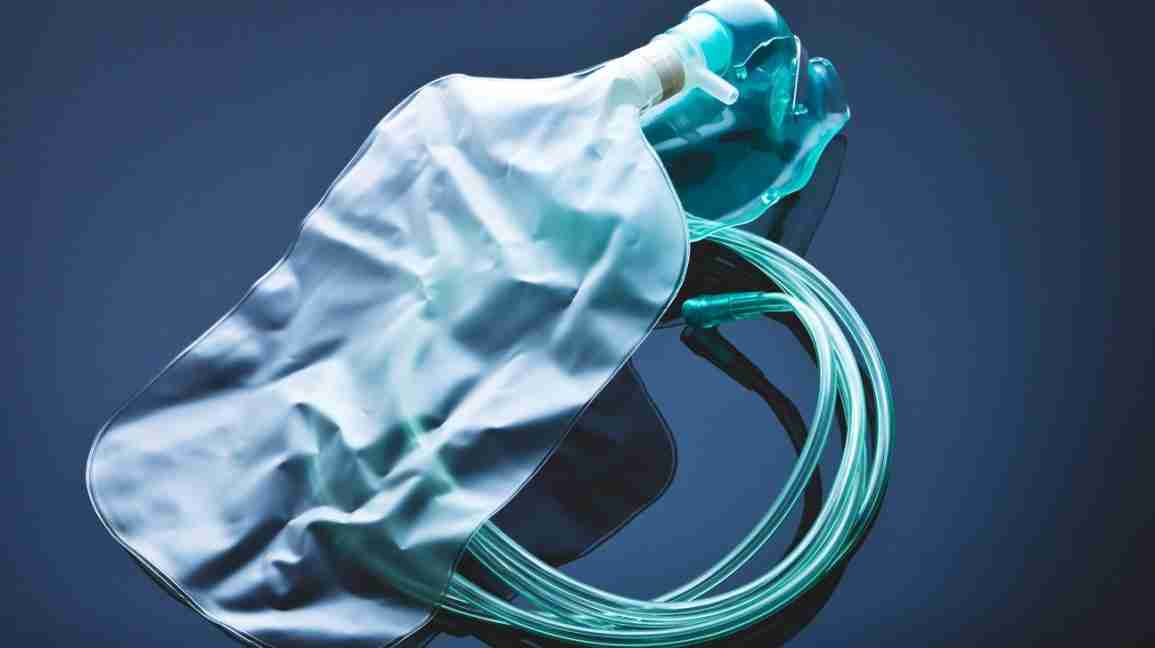Non-rebreather masks are used to deliver oxygen therapy to people who require high-concentration oxygen but aren’t in need of breathing assistance. They’re considered low-flow oxygen delivery systems.
Read on to learn more about non-rebreather masks, when they’re used, and some of the other common types of oxygen masks.
A non-rebreather mask is a face mask that covers both the nose and mouth. It has two one-way valves:
- One valve is between the face mask and a plastic reservoir bag (typically 1 liter) that’s attached to a supply of oxygen. The valve doesn’t allow exhaled air or outside air from entering the bag, so only oxygen flows from the bag to the mask.
- The other valve allows exhaled air to flow into the atmosphere but doesn’t allow the outside air to enter.
This mask is called “non-rebreather” because, when you’re using it, you’re unable to inhale anything you exhale. It allows you to breathe only pure oxygen. A non-rebreather mask typically delivers 70 to 100 percent oxygen.
Most non-rebreather masks don’t form a perfect seal on your face, in which case you’ll also breathe in some of the air around you.
If you need oxygen and are able to breathe without assistance, your doctor may prescribe a non-rebreather mask.
For example, your doctor may prescribe one if you’re experiencing or have recently experienced:
- smoke inhalation
- carbon monoxide poisoning
- physical trauma
- cluster headache
- chronic airway limitation
If your breathing is considered abnormal, your doctor may recommend supplemental oxygen rather than a non-rebreather mask.
Signs of abnormal breathing include:
- noisy breathing, such as wheezing or moaning
- breathing that requires the use of additional muscles, such as the neck muscles
- breathing with pursed lips
- breathing with flared nostrils
Non-rebreather masks aren’t right for every situation. Here are some other types of oxygen delivery you might need to wear depending on the breathing difficulties you’re experiencing.
Partial rebreather mask
Like non-rebreather masks, partial rebreather masks deliver oxygen therapy for people who need high-concentration oxygen but don’t need help breathing.
A partial rebreather mask is a face mask that covers both the nose and mouth. It has one two-way valve connecting the mask and the reservoir bag:
- The two-way valve allows about one-third of exhaled air to get into the bag.
- The two-thirds or exhaled air not getting into the bag flows into the atmosphere.
The partial rebreather mask is so named because, when you’re using it, you’re inhaling, or rebreathing, one-third of what you exhale.
The partial rebreather mask allows you to breathe a mix of pure oxygen combined with your breath for a lower and variable amount of oxygen.
A partial rebreather mask typically delivers 50 to 70 percent oxygen.
Simple oxygen mask
A simple oxygen mask has no reservoir bag and no valves. It typically delivers 35 to 55 percent oxygen. Like non-rebreather and partial rebreather masks, simple oxygen masks are used to deliver oxygen therapy.
Nasal cannula
Your doctor may recommend a nasal cannula if you’re unable to wear a mask due to:
- mouth injury
- claustrophobia
- general discomfort
A nasal cannula is a lightweight tube that’s connected to an oxygen supply on one end. On the other end are two prongs that are placed in the nostrils.
A nasal cannula is considered a low-flow system that mixes oxygen with the air in the room, providing 24 to 44 percent oxygen.
If you’re not able to breathe on your own and need oxygen, your doctor may recommend other types of invasive or noninvasive mechanical ventilation.
A non-rebreather mask is used to deliver 70 to 100 percent oxygen if you need high-concentration oxygen but don’t need help breathing.
Covering both the nose and mouth, a non-rebreather mask has two one-way valves.
One valve allows the inhalation of oxygen from a reservoir bag attached to an oxygen source. The other valve sends exhaled air into the atmosphere and keeps it from getting into the reservoir bag.

